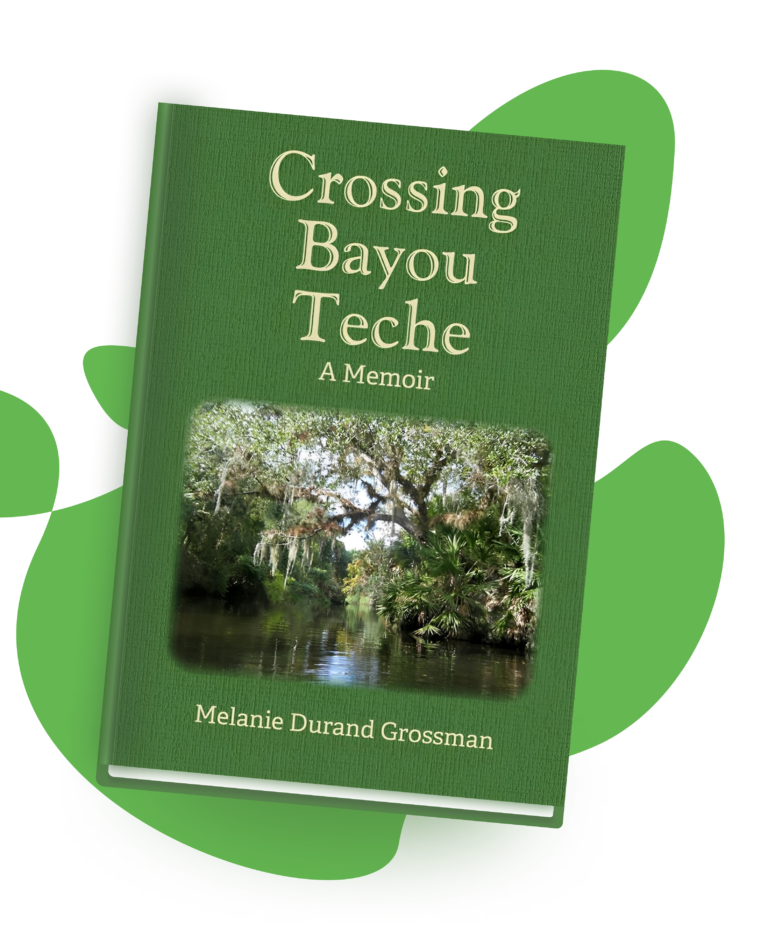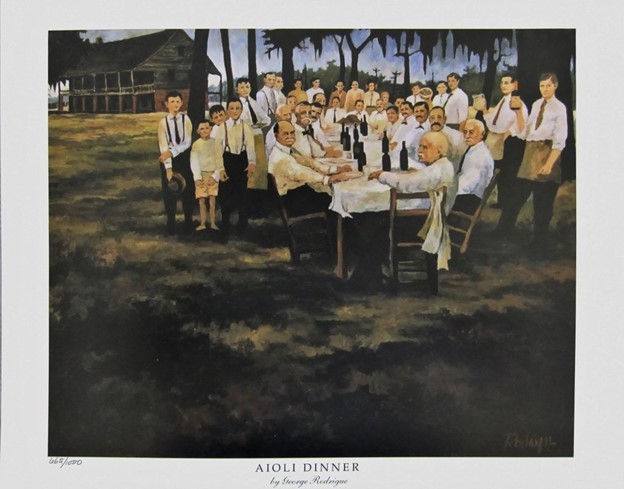
Crossing Bayou Teche
This book is a deeply personal story chronicling the writer’s journey through the changes and upheavals of her own life, but also of the tumultuous times she lived through along the way, such as the Civil Rights Movement, the Cultural Revolution, and the Vietnam War. The author takes us with her as she navigates her interfaith marriage and raises her three children during a time when the values she grew up with, religion, idealism, service to others, and catering to the man of the house, are questioned by the emergence of Feminism and later, the Me Generation.

Meet the Author
Melanie Durand Grossman was born in 1943, in St. Martinville, Louisiana. This small, rural town is situated in the heart of Louisiana’s French Cajun country. At 17, she met a 20 year-old Jewish boy and eloped with him four years later, choosing love and a life of adventure over the life she was born into. Married for 60 years, she shares her Deep South upbringing and interfaith journey in her memoir, Crossing Bayou Teche.
Reviews

Melanie has accomplished a rare feat for any writer, especially a first-time memoirist: crafting a book that captivates the reader from the very first and never lets go. It’s a remarkable tale of two cultures — devout Catholicism of the Louisiana Bayou meets the complex, deeply-rooted Judaism of New York — woven through two distinctly different families, and deftly revealed in a way that endears these real-life characters to us all.But more than a memoir, this is a love story for the ages. Read it to discover; you’ll want to buy extra copies for people you love.
Fran Moreland Johns
Author of Marshallville Stories

[Melanie Grossman] recounts her tale with such insight and meaningful detail that I read her memoir with as much pleasure—maybe more—than memoirs by famous people. Carefully including historical events where they are relevant, Melanie knows how to engage readers. I’ve used insights from this book when teaching a memoir-writing class.
Marion Franck
Staff Writer, The Davis Enterprise Newspaper

People of a certain age who grew up in the 1950’s- 1970s will find this book nostalgic for it tells of the time period when living in a small south Louisiana town was so simple. I certainly remember kids riding around town on their bikes until the streetlights came on and they knew it was time to go home. Get the book, settle in for a good read. You will not regret it!
Marcelle Bienvenu,
Author, Chef and Celebrity Chef

The book is just as likely to bring tears as chuckles as she crosses one seemingly opposite world into another. The drama is real, but the sense of connection with the writer remains throughout. This is a woman’s story of living in a man’s world, but seemingly without rebellion. Her loving nature is communicated both in her tone and the details of her story, a tale that pulls you into the fabric of family and a transformative personal journey.
Glenn Currier,
Poet

It was a delight to travel through Melanie’s vividly remembered past. Candid and personal. Intimate yet charmingly discreet. A fascinating coming-of-age tale from an era just distant enough to feel foreign.
Christinia Ridenhour
San Franciso, CA


Where is Bayou Teche?
At one time, the Mississippi River ran through the lowlands where Bayou Teche, (Teche, rhymes with “Fresh”), now flows. Gradually, the Mississippi shifted its course, leaving behind a place of scenic waterways, rich soil, lush forests, and swamps filled with wildlife. Today the Bayou Teche begins approximately fifty miles from Louisiana’s State Capital in Baton Rouge, and flows in a meandering, southwesterly direction, eventually joining the Atchafalaya River, to empty into the Gulf of Mexico. A National Wildlife Refuge, established in 2001, sits along Bayou Teche, and in 2015 the waterway became part of the National Water Trail System.

What makes this location special?
For the first French trappers and traders, the Teche was the primary means of transportation. The French-Canadian immigrants and others fleeing the French Revolution also settled along its banks, creating a unique culture, music, and cuisine.
There is no one definition of what it means to be a Cajun. Each person’s definition depends on where they were born within the Acadiana area, which stretches west from just outside of New Orleans to the Texas border along the Gulf of Mexico, and about 100 miles inland. But all Cajuns share common bonds when it comes to food, music, family, religion, customs, and traditions.
This website contains my own personal view of what it meant to be a Cajun in the 1940s, 50s, and 60s told through food, music, and my own recollections of some of the customs of the time. You are invited to share your own story of what it means to be a Cajun through the Community Page below.
Note: For a less personal and more historic or academic assessment of Cajun culture, go to:

Thank you George Rodrigue’s estate for allowing to use these beautiful images.
Cajun Food
Cooking was a cherished art for the Cajuns. Recipes were rarely written down but passed from one generation to the next verbally or by watching others cook. The first widely circulated Cajun cookbooks were published in the 1970s. Although Cajun food is famous for being spicy and hot, the dishes are delicious on their own, with only a minimum of added spices.
Music
Cajun songs are traditionally sung in French and accompanied by twin fiddles, an accordion, and a triangle. The music is usually played for dancing and consists most often of waltzes and as a lively two-step. Every community has its own local bands playing at bars, dances, and celebrations. Zydeco music is a more recent offshoot of traditional Cajun music with African American influences including a strong beat and the addition of the washboard, drums, and electric guitar.

Painting by Cajun artist George Rodrigue
https://georgerodrigue.com/blog/

Painting by Cajun artist George Rodrigue
https://georgerodrigue.com/blog/
Cajun Way of Life
For the Cajuns in South Louisiana, the way of life changes slightly depending on the crops grown, the isolation of the area, nearness of urbanized areas, and many other factors. Still religion, love of the outdoors, the celebration of holidays and preservation of certain customs continue to create common values and a distinct identity.

Painting by Cajun artist George Rodrigue
https://georgerodrigue.com/blog/
Join the Community
This community group engages in conversations about food, music, family, interfaith relationships, marriages, and more. Join our community to share your stories about small towns, growing up in a large family, Catholic schools, and your own writings, memoir or otherwise.

